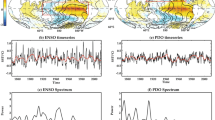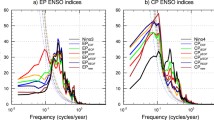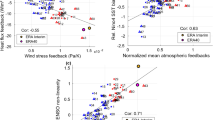Abstract
Using observational data and the pre-industrial simulations of 19 models from the Coupled Model Intercomparison Project Phase 5 (CMIP5), the El Niño (EN) and La Niña (LN) events in positive and negative Pacific Decadal Oscillation (PDO) phases are examined. In the observational data, with EN (LN) events the positive (negative) SST anomaly in the equatorial eastern Pacific is much stronger in positive (negative) PDO phases than in negative (positive) phases. Meanwhile, the models cannot reasonably reproduce this difference. Besides, the modulation of ENSO frequency asymmetry by the PDO is explored. Results show that, in the observational data, EN is 300% more (58% less) frequent than LN in positive (negative) PDO phases, which is significant at the 99% confidence level using the Monte Carlo test. Most of the CMIP5 models exhibit results that are consistent with the observational data.
摘要
本文利用观测资料和CMIP5多模式比较计划的19个模式的工业革命前参照试验数据, 分析了耦合模式对北太平洋年代际振荡(PDO)正负位相下El Niño和La Niña的模拟, 以及ENSO发生频率和PDO位相的关系. 观测中El Niño(La Niña)导致的赤道中东太平洋增温(降温)在PDO正(负)位相下强于负(正)位相, 模式并不能很好地模拟出这种差异. 对于ENSO发生频率在正负PDO位相下的不对称性, 观测显示在PDO正(负)位相下El Niño比La Niña多300%(少58%), 这个结果超过了99%的蒙特卡洛显著性检验. 多模式结果一致反映了观测中的这种现象, 也表明该结果是可信的.
Similar content being viewed by others
References
Allan, R., and T. Ansell, 2006: A new globally complete monthly historical gridded mean sea level pressure dataset (HadSLP2): 1850-2004. J. Climate, 19, 5816–5842, https://doi.org/10.1175/JCLI3937.1.
An, S. I., and B. Wang, 2000: Interdecadal change of the structure of the ENSO mode and its impact on the ENSO frequency. J. Climate, 13, 2044–2055, https://doi.org/10.1175/1520-0442 (2000)013<2044:ICOTSO>2.0.CO;2.
Barnett, T. P., D. W. Pierce, M. Latif, D. Dommenget, and R. Saravanan, 1999: Interdecadal interactions between the tropics and midlatitudes in the Pacific basin. Geophys. Res. Lett., 26, 615–618, https://doi.org/doi:10.1029/1999GL900042.
Bjerknes, J., 1969: Atmospheric teleconnections from the equatorial Pacific. Mon. Wea. Rev., 97(3), 163–172, https://doi.org/10.1175/1520-0493(1969)097<0163:ATFTEP>2.3.CO;2.
Chu, P. S., and J. X. Wang, 1997: Tropical cyclone occurrences in the vicinity of Hawaii: Are the differences between El Niño and non-El Niño years significant? J. Climate, 10(10), 2683–2689, https://doi.org/10.1175/1520-0442 (1997)010<2683:TCOITV>2.0.CO;2.
Dong, X., and F. Xue, 2016: Phase transition of the Pacific decadal oscillation and decadal variation of the East Asian summer monsoon in the 20th century. Adv. Atmos. Sci., 33(3), 330–338, https://doi.org/doi: 10.1007/s00376-015-5130-7.
Dong, X., R. P. Lin, J. Zhu, and Z. T. Lu, 2016: Evaluation of ocean data assimilation in CAS-ESM-C: Constraining the SST field. Adv. Atmos. Sci., 33(7), 795–807, https://doi.org/10.1007/s00376-016-5234-8.
Feng, J., L. Wang, and W. Chen, 2014: How does the East Asian summer monsoon behave in the decaying phase of El Niño during different PDO phases? J. Climate, 27, 2682–2698, https://doi.org/10.1175/JCLI-D-13-00015.1.
Jin, F. F., 1997: An equatorial ocean recharge paradigm for ENSO. Part I: Conceptual model. J. Atmos. Sci., 54(7), 811–829, https://doi.org/10.1175/1520-0469(1997)054<0811: AEORPF>2.0.CO;2.
Kalnay, E., and Coauthors, 1996: The NCEP/NCAR 40-year reanalysis project. Bull. Amer. Meteor. Soc., 77(3), 437–472, https://doi.org/10.1175/1520-0477(1996)077<0437: TNYRP>2.0.CO;2.
Kravtsov, S., 2011: An empirical model of decadal ENSO variability. Climate Dyn., 39(9–10), 2377–2391, https://doi.org/10.1007/s00382-012-1424-y.
Lengaigne, M., E. Guilyardi, J. P. Boulanger, C. Menkes, P. Delecluse, P. Inness, J. Cole, and J. Slingo, 2004: Triggering of El Niño by westerly wind events in a coupled general circulation model. Climate Dyn., 23(6), 601–620, https://doi.org/10.1007/s00382-004-0457-2.
Lin, R., J. Zhu, and F. Zheng, 2016: Decadal shifts of East Asian summer monsoon in a climate model free of explicit GHGs and aerosols. Scientific Reports, 6, 38546, https://doi.org/10.1038/srep38546.
Mantua, N. J., S. R. Hare, Y. Zhang, J. M. Wallace, and R. C. Francis, 1997: A Pacific interdecadal climate oscillation with impacts on salmon production. Bull. Amer. Meteor. Soc., 78, 1069–1079, https://doi.org/10.1175/1520-0477(1997)078 <1069:APICOW>2.0.CO;2.
Newman, M., and Coauthors, 2016: The Pacific decadal oscillation, revisited. J. Climate, 29(12), 4399–4427, https://doi.org/10.1175/JCLI-D-15-0508.1.
Pierce, D. W., T. P. Barnett, and M. Latif, 2000: Connections between the Pacific Ocean tropics and midlatitudes on decadal time scales. J. Climate, 13, 1173–1194.
Shakun, J. D., and J. Shaman, 2009: Tropical origins of North and South Pacific decadal variability. Geophys. Res. Lett., 36, L19711, https://doi.org/10.doi:1029/2009GL040313.
Smith, T. M., R. W. Reynolds, T. C. Peterson, and J. Lawrimore, 2008: Improvements to NOAA’s historical merged land–ocean surface temperature analysis (1880-2006). J. Climate, 21, 2283–2296, https://doi.org/10.1175/2007JCLI2100.1.
Taylor, K. E., R. J. Stouffer, and G. A. Meehl, 2012: An overview of CMIP5 and the experiment design. Bull. Amer. Meteor. Soc., 93, 485–498, https://doi.org/10.1175/BAMS-D-11-00094.1.
Timmermann, A., 2003: Decadal ENSO amplitude modulations: A nonlinear paradigm. Global and Planetary Change, 37(1–2), 135–156, https://doi.org/10.1016/S0921-8181(02)00194-7.
Trenberth, K. E., J. M. Caron, D. P. Stepaniak, and S. Worley, 2002: Evolution of El Niño–Southern Oscillation and global atmospheric surface temperatures. J. Geophys. Res., 107, 4065, https://doi.org/doi: 10.1029/2000JD000298.
Verdon, D. C., and S. W. Franks, 2006: Long-term behaviour of ENSO: interactions with the PDO over the past 400 years inferred from paleoclimate records. Geophys. Res. Lett., 33(6), L06712, https://doi.org/10.1029/2005GL025052.
Wang, B., and S. I. An, 2002: A mechanism for decadal changes of ENSO behavior: Roles of background wind changes. Climate Dyn., 18, 475–486, https://doi.org/10.1007/s00382-001-0189-5.
Wang, C. Z., and J. Picaut, 2004: Understanding ENSO physics—a review. Earth’s Climate: The Ocean-Atmosphere Interaction, C. Wang et al., Eds., American Geophysical Union, 21–48, https://doi.org/10.1029/147GM02.
Wang, H., A. Kumar, W. Q. Wang, and Y. Xue, 2012: Influence of ENSO on Pacific decadal variability: An analysis based on the NCEP climate forecast system. J. Climate, 25, 6136–6151, https://doi.org/10.1175/JCLI-D-11-00573.1.
Yeh, S. W., and B. P. Kirtman, 2005: Pacific decadal variability and decadal ENSO amplitude modulation. Geophys. Res. Lett., 32(5), L05703, https://doi.org/10.1029/2004GL021731.
Yeh, S. W., J. G. Jhun, I. S. Kang, and B. P. Kirtman, 2004: The decadal ENSO variability in a hybrid coupled model. J. Climate, 17(6), 1225–1238, https://doi.org/10.1175/1520-0442(2004)017<1225:TDEVIA>2.0.CO;2.
Acknowledgements
We appreciate the suggestions and comments from the two anonymous reviewers and the Editor, which helped to improve the quality of the original paper. This work was jointly supported by the National Key R&D Program of China (Grant No. 2017YFA0604201), the National Natural Science Foundation of China (Grant Nos. 41576019, 41606027 and 41706028), and the China Postdoctoral Science Foundation (Grant No. 2015M571095).
Author information
Authors and Affiliations
Corresponding author
Rights and permissions
About this article
Cite this article
Lin, R., Zheng, F. & Dong, X. ENSO Frequency Asymmetry and the Pacific Decadal Oscillation in Observations and 19 CMIP5 Models. Adv. Atmos. Sci. 35, 495–506 (2018). https://doi.org/10.1007/s00376-017-7133-z
Received:
Revised:
Accepted:
Published:
Issue Date:
DOI: https://doi.org/10.1007/s00376-017-7133-z




